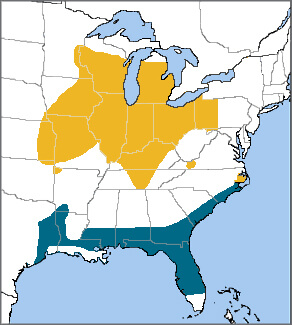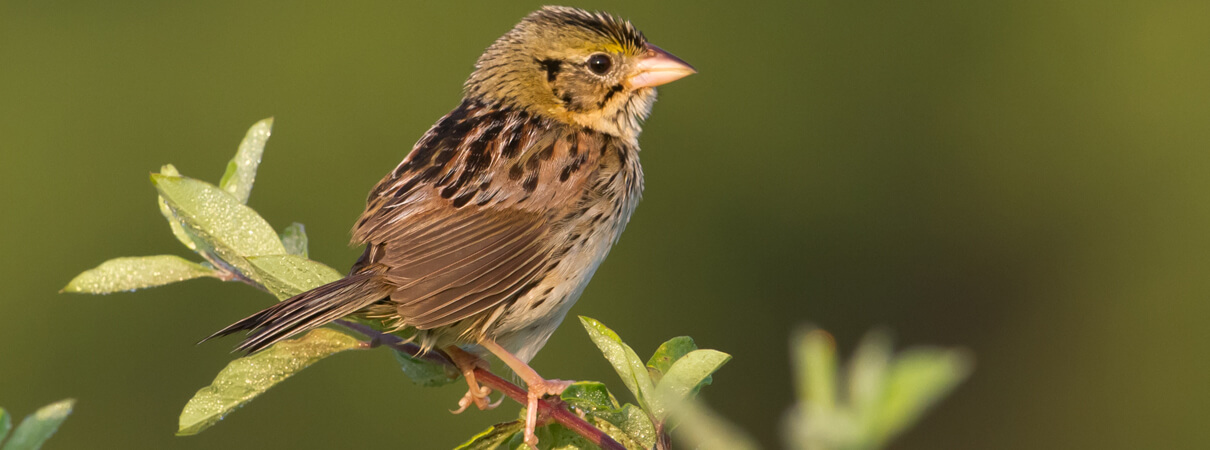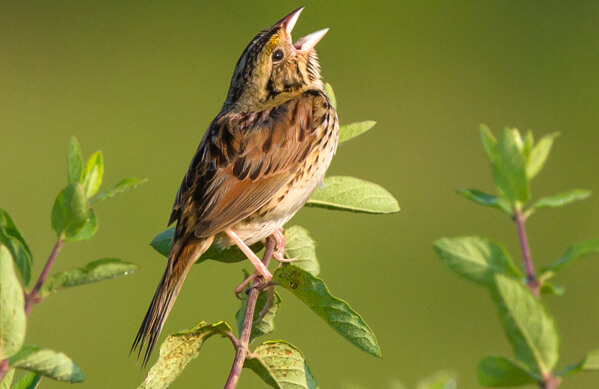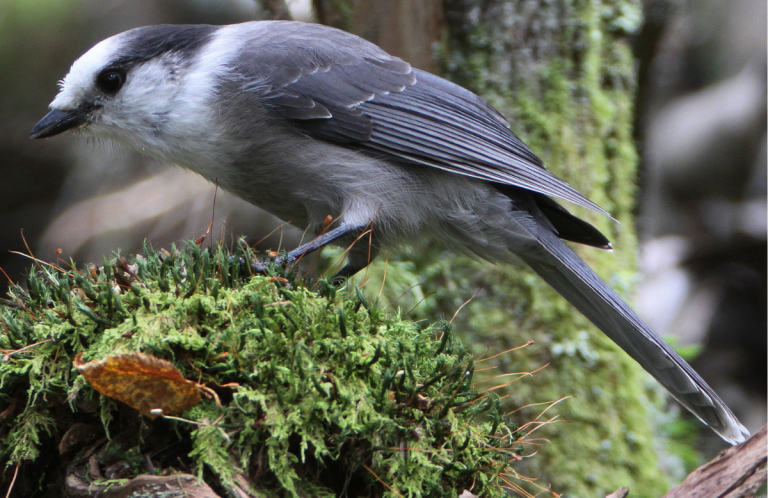
Henslow's Sparrow range map by ABC. Yellow represents breeding range; blue is nonbreeding.
The Henslow's Sparrow and its close relative, the Baird's Sparrow, are the only two sparrows in the genus Centronyx (meaning spurred claw). This name refers to these birds' long hind toes, a feature found in other ground-dwelling grassland birds such as the Thick-billed Longspur.
Like Baird's, Henslow's Sparrow was named by John James Audubon in honor of a friend — in this case, John Stevens Henslow, a botany professor at the University of Cambridge and a teacher of Charles Darwin.
Hidden Hiccup
Although Henslow's Sparrow has a unique olive-green head and nape, it often goes unnoticed. The birds take flight only reluctantly, preferring to run through the grass when threats appear. The best way to find this bird is by listening for its very distinctive song, a quiet, abrupt "see-LICK" that sounds for all the world like an avian hiccup.
Although males establishing territories sit within binocular range while singing this odd song, they often remain unseen. Henslow's Sparrows most often "hiccup" from deep within the brushy, grassy habitat the species favors. And they are very persistent singers: Males sometimes sing every few seconds, day and night, around the clock. Deep in the night on a quiet prairie, these brief songs and insect noises will often be the only sounds. Listen here:
(Audio of Henslow's Sparrow by Todd Wilson, XC42754. Accessible at www.xeno-canto.org/42754)
Henslow's Home Range
Prior to European settlement, the species bred primarily in prairie habitats. As native grasslands were lost on a large scale to agriculture, populations sprang up in secondary grassland habitats such as hayfields, pastures, and even reclaimed strip mines. This adaptability has allowed the bird's range to expand to the north and the east as forests were cleared.
At present, Henslow's Sparrow breeds locally from Minnesota, southern Ontario, and central New York south to northern Oklahoma, Illinois, and a patch of North Carolina. It once bred throughout New England, but has been largely extirpated there due to habitat loss. This sparrow winters within the United States, migrating as far south as the Gulf Coast states and occurring on the southeastern Atlantic Coast up to North Carolina.
Colony Concerns
Like the Grasshopper Sparrow and Lark Bunting, Henslow's Sparrow consumes large quantities of insects in the summer, especially grasshoppers and beetles. During winter months, seeds and berries constitute more of the diet.
Henslow's Sparrow males establish and maintain territories, mainly through their hiccuping song. The species often breeds in loose colonies, which require relatively large fields of appropriate habitat to accommodate a set of territories.
The female builds her nest, a deep cup of grasses, at the base of a thick clump of vegetation just one, two, or three inches above the ground. Most nests contain four to five eggs, which the female incubates alone for ten to 11 days. Both parents feed the young, which leave the nest nine to ten days after hatching. Henslow's Sparrows often raise two broods per season.

Henslow's Sparrow. Photo by Frode Jacobsen.
Helping to Save Henslow's Habitat
Habitat loss is the greatest threat to Henslow's Sparrow and other grassland birds, including the Bobolink and Dickcissel. A 2019 study showed that grassland species experienced a 53-percent reduction in population — a loss of more than 720 million birds — since 1970. Collisions with towers and buildings also pose a significant risk to Henslow's Sparrow, particularly during its fall migration.
ABC's work with Joint Ventures, particularly landowners within the Central Hardwoods Joint Venture, has yielded positive conservation results for grassland species, and our collaboration with the Sustainable Forestry Initiative in the southeastern United States helps to maintain important wintering habitat for this species and many others. Our collisions program offers solutions to keep migrating birds safe during their southbound journeys, while our BirdScapes approach to conservation is working to conserve essential habitat for Henslow's Sparrow and other declining species wherever they land.
Donate to support ABC's conservation mission and have your gift matched 1:1 now!



















































